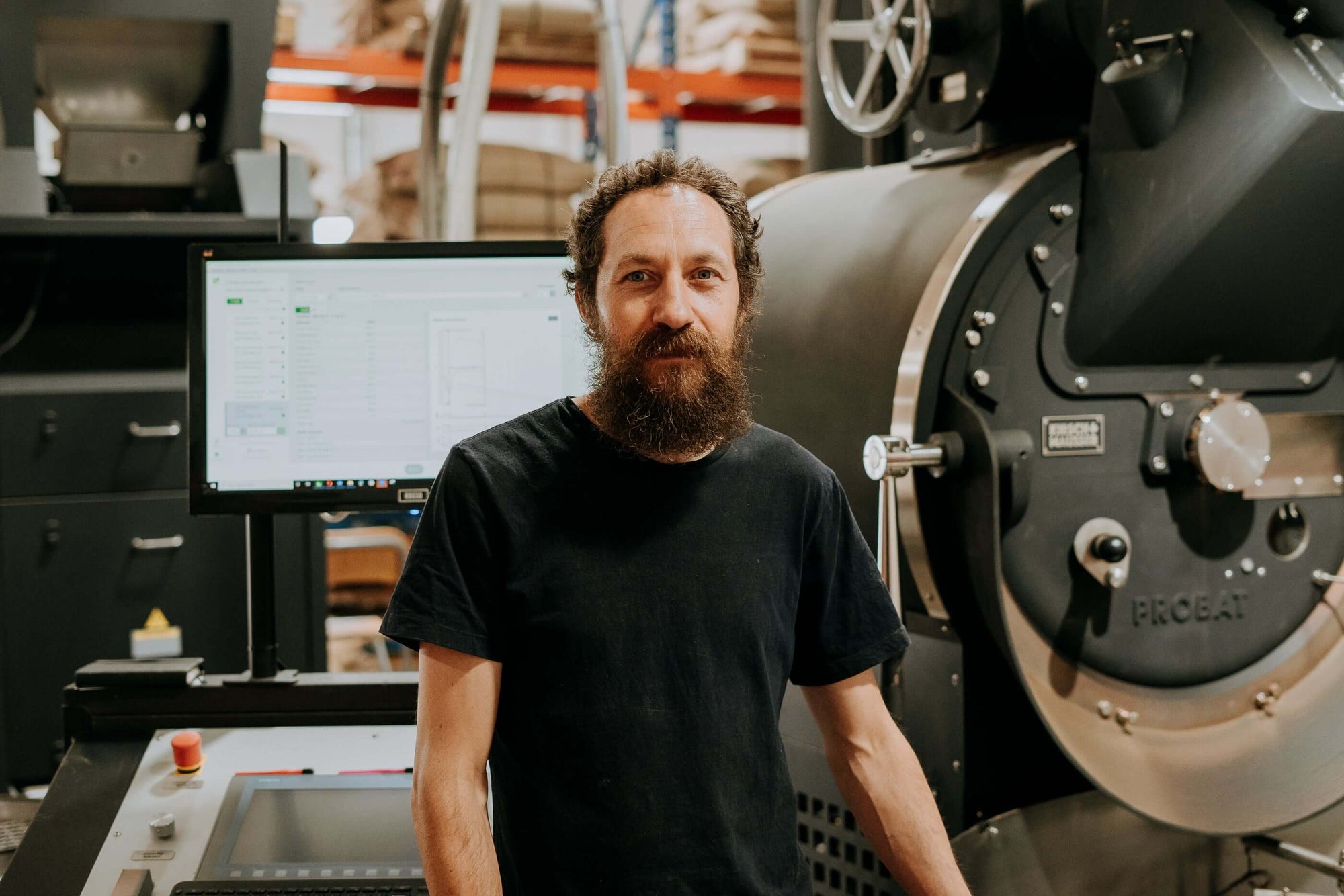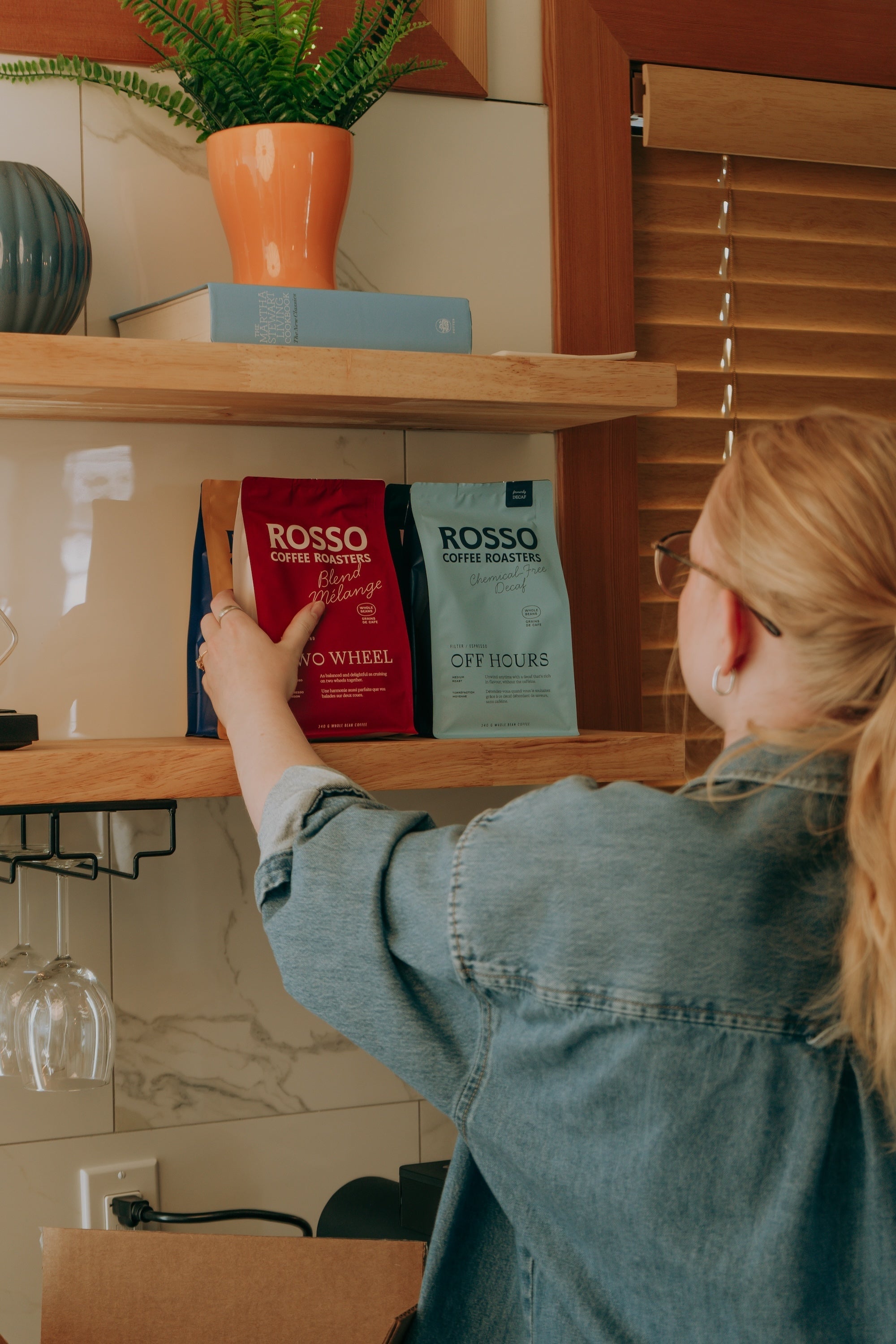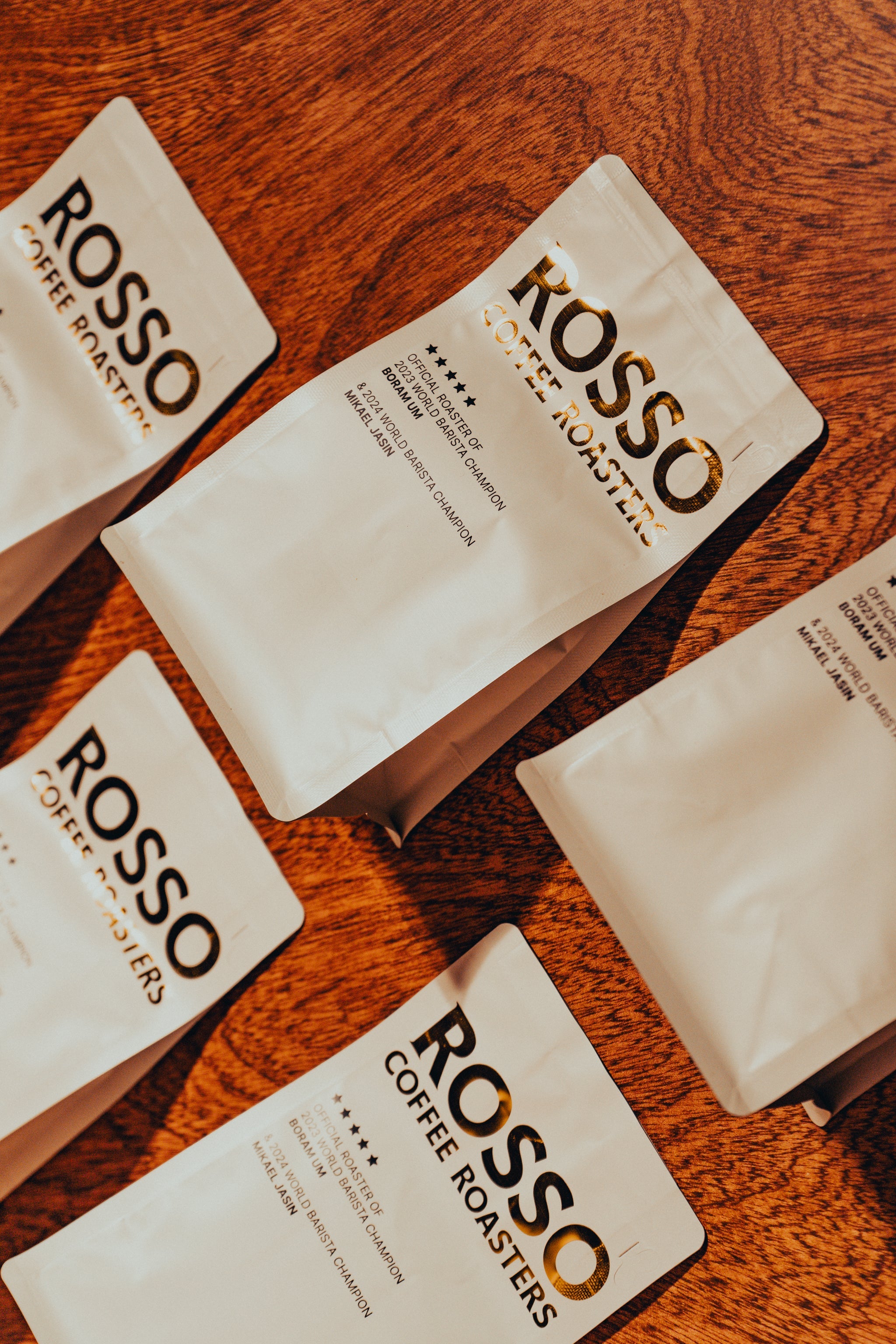

In Conversation with Paul Stephens
I sat down with Paul Stephens, Rosso’s head roaster, and asked him about all things roasting. I learned a lot about what it requires to take your coffee from the green bean all the way to the finished cup you find in cafes. I hope you learn something new too!
You can check out an Podcast conversation with Paul and David on Buy The Drip

Me: What exactly does a coffee roaster do?
Paul: A coffee roaster roasts coffee. You’re trying to get it from green to the level of roast you want in a certain time and in a certain way. It’s about the journey a bean goes through from start to finish. There’s many ways of getting from that starting point to the end point. And it’s how you get there that changes the flavor.
You could just put the coffee in maximum heat as quickly as you can and get it up to that end temperature and then dump it. But, it wouldn’t be the same. Even though it reaches the same end temperature or the same apparent colour. It’s about trying to find the best way to roast it all the way through.
Me: What happens during the roasting process?
Paul: It’s very complex. But, in general, it’s about sugar browning. It’s the same as a piece of toast, for instance. The toast goes brown because of the sugars in there that are being converted. That’s the main thing that happens to coffee to make it go brown, so you get those nice roasted flavors. If you roast it too much, then it gets too dark and you’ve roasted all those sugars away.
Me: Is there a step by step process when roasting?
Paul: Yes. When the green coffee goes in, for the first couple of minutes it’s just drying out, losing moisture. There’s no actual roasting going on, because the moisture’s preventing it from roasting. Then once some of that moisture has escaped, you’ll see the coffee start to change colour. That’s when the roasting starts. The initial flavors you’ll find here are slightly toasty, bread-like. But not really the kind of coffee flavor people are used to. Your goal is to continually increase temperature, from the initial room temperature of the green beans to the desired end temperature. All coffee reaches a point that they call first crack. So, at that point, the coffee audibly pops and starts to break apart slightly and the gasses start exploding out. That’s your benchmark, the minimum that you can roast. Once it’s gone through first crack, anything after that, which is called development time, is just deciding when to stop and how far to take it to its finishing point. At a higher temperature the coffee can go through a second crack. During this second crack, the beans really break apart and oils come to the surface. At this point, the beans become a darker roast.
Me: Would you do that for Turning Point and Basecamp?
Paul: Basecamp, our darkest roast is right on the cusp of second crack. They still don’t crack. That’s when the coffee tends to get really oily and the oils start coming out, which isn’t ideal. Because in lighter roast coffees, the oils are all trapped inside, they stay there until you grind it. It helps to preserve those moistures and stop them from oxidizing.
Me: What initially drew you towards roasting? Why does it interest you?
Paul: I was drawn towards coffee around the late 90s. I had pulled some espresso shots in a store before. A pretty old school one. I used to play around at home. I had a little espresso machine and just liked playing around with coffees and buying coffees and things. And then the opportunity came up for a job in the UK, to work in a cafe. But, it was a new cafe, and they had this small coffee roaster. They were one of the first of the third wave cafes that had a roaster in it. My boss, at the time, had only done a short course to learn how to use it, so he wasn’t a roast master or anything. Not long after I started, he realized they needed somebody else to roast because he had to deal with lots more of the administrative stuff and running a business. And seeing as I was the most interested in the coffee side of things, I started doing that.
I really like cooking. I’ve always liked cooking. I cook everyday. So, I like the idea of transforming the raw ingredient into something that tastes really good. You’re really only dealing with one thing, that one ingredient, coffee, so you’re just super focused on that one thing and making it taste as good as you can. I think anybody who is interested in cooking would see the parallels between those two things.

Me: And how long does the process take each time? Or does it vary?
Paul: There is some variation. It’s around nine minutes. All our roasts are around this length of time.
Me: And how often do you receive new coffees to roast?
Paul: I mean we pretty much get new coffees every couple of months. When you get a new coffee, it takes awhile to develop the right profile for it.
Me: So, there’s some play room at first for each different coffee?
Paul: You’ll have an idea of what kind of coffee it is. You could base it on a similar coffee you’ve roasted before. Or if there’s a new crop with the same coffee, it would tend to be a similar roast. But it will change year to year, so you’ll have to tweak it slightly.
Me: What was the most difficult coffee you’ve ever roasted and why was it such a challenge?
Paul: I think probably one of the most difficult is one of the current ones, the Pacamara, that goes into Day Tripper. Because of the heavy processing it goes through, the fermentation, the beans are really uneven. They’re very large beans as well. The biggest beans we have. So, some of them you can easily over roast. Whereas, other ones don’t. And we do a small batch, so the smaller batches are harder on the big roaster, because the temperatures can jump up and down quickly. It’s very difficult to get it just right.
Me: So, you’re only doing small batches of this one?
Paul: Yeah, because it’s blended in such a small quantity. It’s probably the smallest sized batch we do on a large roaster. Because there’s not a big thermal mass of coffee there, if you turn it down too much, the temperature will drop. But, you don’t want it to get too high as well, so I try to find that fine line.
Me: So, the Pacamara goes into the Day Tripper? What other coffee goes in there currently? Is it a blend?
Paul: It's a blend, yeah. The other one’s fairly straight forward, Bumbogo. We’re using a standard profile for that. And La Esperanza, we’re using a slightly smaller batch but, again, washed coffees tend to be fairly straightforward and easy to roast, but any of the ones that have lots of fermentation on them, are a bit more tricky. So, I try to get it to first crack very gently, so it doesn’t crack too aggressively.
Me: How do you do it more gently?
Paul: I take a little bit longer. You’re always lowering the flame throughout the roast anyways, but as the temperature goes up, you’re slowly turning the flame down. It’s almost like bringing food to a boil and then letting it simmer. But we’re trying to get a much lower simmer when it hits first crack, so it doesn’t take off and the coffees don’t get too dark.
Mel: So, you don’t bring it to a boil as much?
Paul: Yeah, if you were to put on a roast at high heat until you got to first crack, you would probably hit first crack and it would keep going and it would go to second crack pretty quickly. You wouldn’t be able to stop it. It would barrel ahead. It would be too late to turn the gas down at that point. The coffee would already have that inertia to just keep going. So, you’re trying to always control the heat so you don’t get too much inertia. Again, you don’t want it to plummet when it hits first crack. You don’t want the temperature to disappear.
Mel: What type of a roaster do you work on?
Paul: It’s a drum roaster. It’s a G45 by K&M. The company K&M is a German offshoot of Probat. So, it’s essentially a Probat roaster from an old design. It’s a newly manufactured roaster using the same specifications, but they’ve added lots of new features. Such as, you can alter the drum speed, you can alter the airflow, it measures the drum pressure. So, there are lots more variables that you can monitor to make the roast consistent.

Me: So it’s an old model with new features?
Paul: Yeah. Lots of people were trying to hunt around to find the old ones and refurbish them, because they were very heavy-built. Lots of cast iron. It holds a lot of heat, so once it’s hot it becomes very stable. So, that’s why they started remanufacturing them.
Me: How does that one compare to the roaster at Ramsay?
Paul: It’s similar, but the one at Ramsay is a Probat. It’s smaller. It’s a very similar kind of roaster. But, it’s just scaled up and a bit more adjustable. In the UK, I used Diedrich roasters, which are American. They’re a drum roaster, as well, but instead of having the big powerful gas burners they have infrared gas burners. There’s a lot less thick, heavy metal on them. So, they’re a lot more delicate. It’s easier to burn the coffee in them. They are more sensitive to smaller batches, though. There’s pros and cons with different roasters. You just have to learn how to use your particular roaster. The good thing about this roaster is we have so much feedback we can measure.
Me: What things/items have the largest effect on a roast?
Paul: Development time is probably the biggest factor - that’s how long you keep the coffee in the roaster after first crack. And the end temperature is a factor, as well.
Me: So, for the most part you can control what happens to the coffee. No circumstances prohibit that?
Paul: You can control it, yeah. I do find the differential temperature from inside the room and outside makes a difference. So, when it’s very cold outside you get more of a draw through the flu, the same as you would at home with a fireplace. You’d get a lot more airflow. So, the roasts tend to start to get a bit quicker in the winter, but you can adjust the profile to suit that. You can see from the previous roast that if it’s always going to be ahead, you can adjust the temperature you put the beans in at and try to get back on track.
Me: Which coffee is your favourite right now to roast? To drink?
Paul: I really enjoy the Mokka to drink. It’s tricky to roast, though, because it’s a smaller batch. I don't know whether that’s enjoyable or not. The Bumbogo is probably the most consistent roast at the moment, it behaves itself pretty well so it’s quite enjoyable to put in.
Me: How was roasting in the UK vs Canada? Are there differences or similarities?
Paul: There’s a similar ethos, but in general, we roasted lighter in the UK. I didn’t roast anything like Basecamp, that level of darkness. But I think there’s more of a demand for that in North America, those darker roasts. A lot of Northern Europe is quite light. Especially in the specialty coffee industry.
I wasn’t using any computer software. I was just charting the temperature every minute. I had sheets printed out and every minute I’d write down the temperature. I’d be referencing it from the last time, so I could see if I was ahead temperature-wise.
Me: Is the computer software a lot easier to use, more consistent?
Paul: Yeah, it’s definitely easier to use because you can see it in real time, see the graphs, and see where you’re going. I know when I started here, they’d only just started using software here as well. I think my first roast was maybe the 300 or 400th Rosso had done, using the software. And now we’re over 30, 000 roasts.
Me: What exactly is happening on the computer when you roast? Is there science and math behind that?
Paul: Yeah, the computer program is called Cropster, which is a third party program. That’s the most popular one people use. You can use it with any roaster, as long as you have the temperature probes. It measures all data and it clocks it on the graph, so you can watch it as you’re roasting. You can make notes of gas changes and other variables. These get saved once you finish the roast. If you think that this was a particularly good tasting batch, then you can set that profile as the reference for all future roasts of that coffee. So, I was kind of doing that on paper in the UK. I knew what numbers I should be hitting and at which times. But it’s way easier on the computer, because if you see you’re slightly behind then you can make an effort to catch up or get back on track. And every single roast we do is all saved in the database, which also means that if someone has an issue with the coffee, we can look back and see if something happened during the roast.
Thanks for the inside look at roasting, Paul!

1 comment
-
I had the pleasure to work with Paul back in UK, I can say all good things about this beautiful soul and Great Roaster Master.
At that time I wasn’t speak a good english, but wasn’t a problem with Paul. I learned so much from him.
Thank you Paul!Alessandro on










